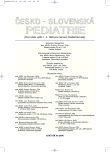Familial Hypomagnesemia with Hypercalciuria and Nephrocalcinosis – Cases and Differential Diagnosis
Authors:
J. Behúnová 1; Ľ. Podracká 1; E. Sádová 1; Z. Kurcinová 2; A. Kováčová 3
Authors‘ workplace:
1. Klinika detí a dorastu, Lekárska fakulta UPJŠ a Detská fakultná nemocnica, Košice
prednostka prof. MUDr. Ľ. Podracká, CSc.
1; Urologická klinika, Fakultná nemocnica L. Pasteura, Košice
prednosta doc. MUDr. L. Valanský, CSc.
2; Oddelenie klinickej biochémie, Fakultná nemocnica L. Pasteura, Košice
primárka MUDr. A. Kováčová, CSc.
3
Published in:
Čes-slov Pediat 2006; 61 (10): 578-585.
Category:
Case Report
Overview
Familial hypomagnesemia with hypercalciuria and nephrocalcinosis is a rare AR inherited disorder with not favorable prognosis regarding renal functions. End-stage renal disease is present in 1/3 of adolescent patients, timing of renal failure correlates with severity of nephrocalcinosis. Molecular nature of disease is based on mutations of gene encoding protein paracellin-1 (claudin-16), which is expressed in medullar and cortical segment of Henle loop. This protein takes place in the structure of tight intercellular junctions which are important for paracellular transport of Mg and Ca. Nephrolithiasis has been described also in heterozygotes.
The authors refer to two unrelated cases. A 5 year-old boy with history of nephrolithiasis had findings of hypomagnesemia, hypermagnesiuria, hypercalciuria, hypocitraturia, hyperparathyreosis, slight hyperuricaemia and ultrasound finding of nephrocalcinosis. Renal losses of other ions, glucose, aminoacids, proteins and oxalates were not present. Renal functions were slightly decreased, concentration ability was lowered, but without polyuria. Test of acidification excluded renal tubular acidosis. Diastolic hypertension was confirmed. Other examinations were (except of slightly positive Chvostek sign) within physiologic ranges. Family history was positive for nephrolithiasis in the father’s sister. Another 5 year-old boy was admitted for acute abdominal pain, abdominal X-ray revealed severe nephrocalcinosis, laboratory findings were similar as above, just somewhat milder and without hyperparathyreosis.
For differential diagnosis some other disorders should be excluded:
disorders of intestinal magnesium absorption and magnesium-loosing renal diseases: 1. Activating mutations in Ca-Mg receptor with hypercalciuria, nephrocalcinosis and hypoparathyreosis, 2. Salt loosing tubular disorders – Bartter syndrome (I, II, III, IV) and Gitelman syndrome, 3. Isolated hypomagnesemia, recessive one without any other defect, and dominant hypomagnesemia with hypocalciuria.
Key words:
hypomagnesemia, hypermagnesiuria, hypercalciuria, nephrocalcinosis, renal failure, differential diagnosis
Labels
Neonatology Paediatrics General practitioner for children and adolescentsArticle was published in
Czech-Slovak Pediatrics

2006 Issue 10
Most read in this issue
- Diabetic Ketoacidosis
- The First Case of Glucose Transporter Type 1 (GLUT-1) Deficiency Syndrome in Slovakia
- Therapy of Diabetic Ketoacidosis
- Familial Hypomagnesemia with Hypercalciuria and Nephrocalcinosis – Cases and Differential Diagnosis
